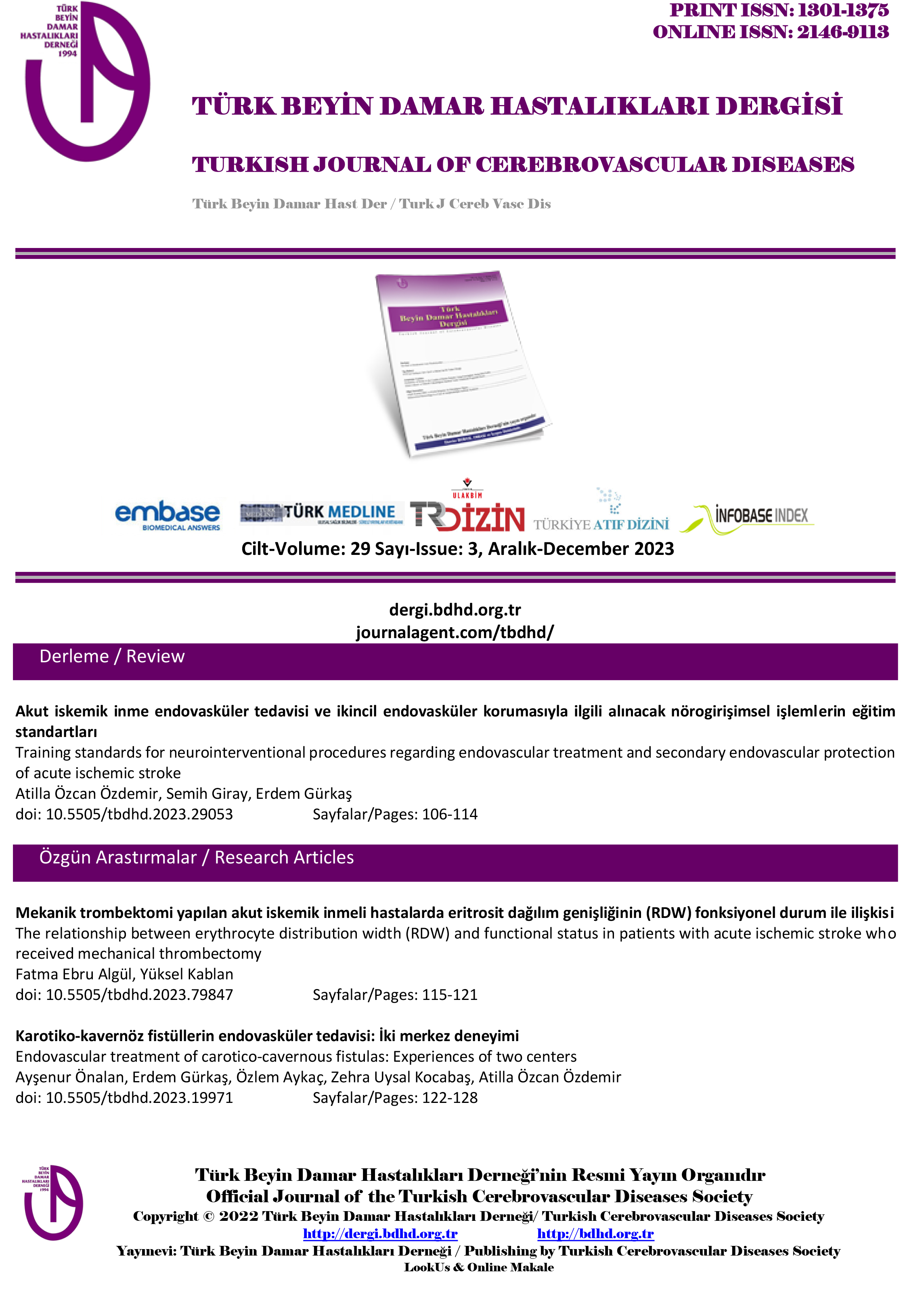The effect of lipoprotein(a) level on the efficiency and safety of intravenous thrombolytic therapy
Ezgi Yılmaz1, Elif Sarıönder Gencer2, Ethem Murat Arsava1, Mehmet Akif Topçuoğlu11Department Of Neurology, Hacettepe University, Ankara, Turkey2Department Of Neurology, University of Health Sciences, Antalya Training And Research Hospital, Antalya, Turkey
INTRODUCTION: Increased lipoprotein(a) (Lp(a)) is an atherosclerotic cardiovascular disease risk factor that has the potential to be used in clinical practice. Antifibrinolytic effects have been reported due to its structural similarity with plasminogen. In our study, the effect of Lp(a) level on the response to intravenous tissue plasminogen activator(iv tPA) in acute ischemic stroke was investigated.
METHODS: Among the patients evaluated at Hacettepe University Hospital in the last 15 years, those who received tPA treatment and had Lp(a) levels checked within 72 hours were reviewed in terms of tPA efficacy, prognosis and hemorrhagic transformation. Response to iv tPA treatment was divided into 2 categories according to NIHSS decrease at 24 hours (effective response: decrease of at least 4 points or zero, dramatic response: decrease of at least 8 points or zero or one) 0 and 1 were rated as 'excellent outcome', 0, 1, and 2 were rated as 'good outcome' according to the modified Rankin score (mRS) evaluated at 3 months. IV tPA-related hemorrhagic transformation was evaluated according to Fiorelli's classification.
RESULTS: 203 patients (mean age 71±14;108 women) with iv tPA treatment; an 'effective response' was observed in 46% and a 'dramatic response' was observed in 29%. According to the mRS of the patients at 3 months, 33% had an excellent outcome and 51% had a good outcome. After IV tPA treatment; cerebral hemorrhage of any severity in 19% of patients; parenchymal hematoma type 2 was detected in 5% of them. In analyzes performed according to prognosis, iv tPA response and post-tPA cerebral hemorrhage status, there was no difference in Lp(a) level and the frequency of subgroups (>30 mg/dl, >60 mg/dl, >100 mg/dl) formed with three different cut-off values.
DISCUSSION AND CONCLUSION: The results of our study suggested that the antifibrinolytic effect due to Lp(a) was so low that it did not affect the tPA activity. Prospective studies with larger participation are needed to better demonstrate this antifibrinolytic effect, which is thought to be weak.
İntravenöz trombolitik tedavi etkinlik ve güvenilirliğine lipoprotein(a) düzeyinin etkisi
Ezgi Yılmaz1, Elif Sarıönder Gencer2, Ethem Murat Arsava1, Mehmet Akif Topçuoğlu11Hacettepe Üniversitesi Tıp Fakültesi, Nöroloji Ana Bilim Dalı, Ankara2Sağlık Bilimleri Üniversitesi Antalya Eğitim Araştırma Hastanesi, Nöroloji Ana Bilim Dalı, Antalya
GİRİŞ ve AMAÇ: Lipoprotein(a) (Lp(a)) yüksekliği klinik pratikte kullanılabilme potansiyeline sahip bir aterosklerotik kardiyovasküler hastalık risk faktörüdür. Yapısal olarak plazminojenle gösterdiği benzerlik nedeni ile antifibrinolitik etkileri bildirilmiştir. Çalışmamızda Lp (a) düzeyinin, akut iskemik inmede intravenöz doku plazminojen aktivatörüne (iv tPA) yanıta olan etkisi incelenmiştir.
YÖNTEM ve GEREÇLER: Son 15 yıl içerisinde Hacettepe Üniversitesi Hastanesinde değerlendirilen IV tPA tedavisi almış ve 72 saat içinde bakılmış Lp(a) düzeyi olan hastalar tPA etkinliği, prognoz ve hemorajik transformasyon açısından incelendi. NIHSSde 24.saatte en az 4 puan azalma ve ya sıfıra düşme iv tPA tedavisine etkin cevap; 8 puan ya da daha fazla azalma ve ya sıfır ya da bire düşme dramatik cevap olarak kategorize edildi. Üçüncü ayda değerlendirilen modifiye Rankin skoru (mRS)na göre 0 ve 1 mükemmel sonlanım; 0, 1 ve 2 iyi sonlanım olarak değerlendirildi. IV tPA ilişkili hemorajik transformasyon Fiorellis sınıflamasına göre değerlendirildi.
BULGULAR: 203 hastanın (yaş ortalaması 71±14; 108 kadın) %46sında iv tPA tedavisi ile etkin cevap, %29unda dramatik cevap izlendi. Hastaların 3. aydaki mRSlarına göre %33ünde mükemmel sonlanım, %51inde iyi sonlanım olduğu gözlendi. İv tPA tedavisi sonrası hastaların %19unda herhangi bir ağırlıkta serebral hemoraji saptanırken; %5inde parankimal hematom tip 2 saptandı. Prognoz, iv tPA cevabı ve tPA sonrası serebral hemoraji durumuna göre yapılan analizlerde Lp(a) düzeyi ve üç farklı kesim değeri ile oluşturulan subgrupların (>30 mg/dl, >60 mg/dl, >100 mg/dl) sıklığı açısından bir farklılık saptanmadı.
TARTIŞMA ve SONUÇ: Çalışmamızın sonuçları Lp(a) ya bağlı antifibrinolitik etkinin tPA etkinliğini etkilemeyecek kadar düşük seviyede olduğunu düşündürmüştür. Zayıf olduğu düşünülen bu antifibrinolitik etkinin daha iyi ortaya konulabilmesi daha geniş katılımlı prospektif çalışmalara ihtiyaç vardır.
Corresponding Author: Ezgi Yılmaz, Türkiye
Manuscript Language: Turkish










